
Education
•
Feb. 25, 1934
Born, Springfield, Missouri, to Alberta Grace Stimpson Drake and George Bryant Drake
•
1952
Graduates Lyons Township High School, LaGrange, Illinois
•
Fall 1952
Matriculates as Grinnell College Baker Scholar
•
1952–1956
Excels as scholar-athlete; active and engaged across campus, develops lasting friendships with faculty and classmates; senior year leads cross-country team to its first conference championship and personally qualifies for national championships
•
1956
A Phi Beta Kappa, George wins Archibald Prize for highest grades in his class
•
1956–1957
Fulbright Scholar, studies French Protestant history, University of Paris, France
•
1957-1959
Rhodes Scholar, studies modern British history, Merton College, Oxford University, England, receives B.A. and M.A.
•
1959–1964
Years under the aegis of the University of Chicago/Chicago Theological Seminary; B.D. (Divinity), 1962; M.A., 1963; Ph.D. in church history, 1964. Rockefeller graduate fellow
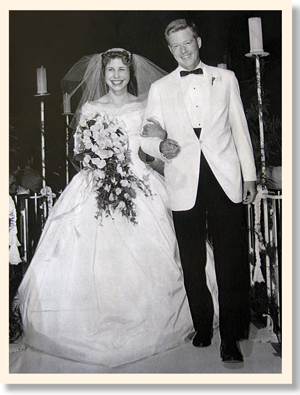 The 1960 wedding of George Drake ’56 and Susan Ratcliff ’58 at Ladue Chapel in St. Louis.
The 1960 wedding of George Drake ’56 and Susan Ratcliff ’58 at Ladue Chapel in St. Louis.When my father turned 80, I was working in Grinnell’s Development and Alumni Relations office. In that role, I discovered that an unanticipated job perk was alumni and Grinnell colleagues sharing stories about my dad and what he meant to them. What they told me emphasized how important relationships were to him and how carefully he cultivated them. As Dad’s birthday approached, I reached out to these individuals, encouraging them to write these accolades directly to him. The missives flooded in through mail, email, and even on Facebook. Over the next weeks, my father not only read each one, but, true to character, answered all that he could. Eight years later, as Dad entered hospice care at the end of his journey with pancreatic cancer, his granddaughter, Hannah Drake ’18, shared this news with the Grinnell community. A similar outpouring of messages came in, and we were able to read many of them to him during his final days.
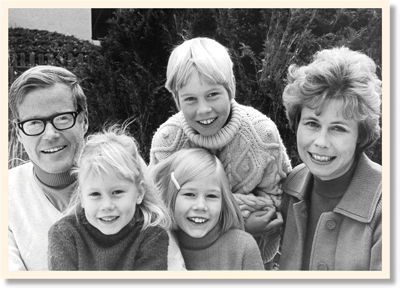 The Drake family, 1975, in Colorado Springs where all three children were born (L–R: George, Melanie, Cindy, Chris, and Sue).
The Drake family, 1975, in Colorado Springs where all three children were born (L–R: George, Melanie, Cindy, Chris, and Sue).Common themes emerge from these messages. George Drake was a good listener. He genuinely engaged with each person, asking questions that allowed him to get to know them and allowed them to feel heard. He was responsive. He helped problem-solve. He pushed people to enhance their own learning and being. His humility endeared him to others. And the vast knowledge and intellect he shared was notable and appreciated. These sentiments were no surprise to his loved ones, but what struck us was how fully Dad was able to connect with so many individuals, even those he encountered only briefly. As I have absorbed this and observed my father getting to know people (most recently in hospital settings, whether the nurse on duty or the person cleaning his room), I know that Dad never met a stranger; from the moment of greeting, he immediately connected, learning from them as much as about them.
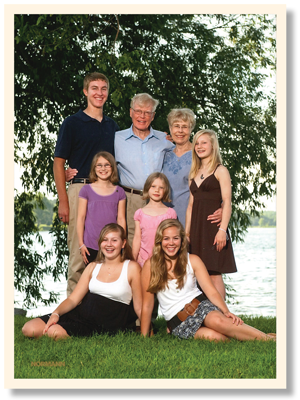 A new generation; their six grandchildren with George and Sue at their Golden Anniversary in 2010 (back row, L–R: Nick, George, Sue, Danielle; middle row, L–R: Lila, Sam ’25; seated, L–R: Hannah ’18, Elizabeth).
A new generation; their six grandchildren with George and Sue at their Golden Anniversary in 2010 (back row, L–R: Nick, George, Sue, Danielle; middle row, L–R: Lila, Sam ’25; seated, L–R: Hannah ’18, Elizabeth).The constant in Dad’s life, through which he cultivated many of these relationships, was Grinnell College. His life path was greatly impacted when he was recruited out of Chicago to this small Iowa school by Coach John Pfitsch. A self-described “indifferent high school student,” Dad remembered his father’s words when his parents dropped him off at the College. “George, I’m not worried about you making friends or having success in sports. I’m worried that you’ll flunk out.”
He took his father’s words to heart, knowing that college was costly ($1,300 annually in 1952!) and committed himself to being the student his dad didn’t think he could be. As Dad put it, “Grinnell turned me on. It was fun to work hard, and I loved the classes.” And he didn’t sacrifice friends or athletics in the process. His running prowess that got him into Grinnell continued to hold steady. Years later, at reunions, Dad’s classmates would tell me memories of sitting in the stands, hearing George Drake’s name called over the loudspeaker as they watched him effortlessly stride around the track.

Family and Early Career
•
Fall 1959
Reconnects with fellow Grinnellian Susan Ratcliff ’58, beginning a “whirlwind courtship”
•
June 25, 1960
Marries Sue Ratcliff at Ladue Chapel, St. Louis
•
1960–1961
Returns to Grinnell through Rockefeller grant to intern with chaplain, teach as instructor of history, serve as men’s soccer coach; Sue teaches at Cooper Elementary
•
1961, 1962
Takes a summer job as pastor of a small mountain church in Marble, Colorado, spending two consecutive summers in this role
•
Early 1960s
George and Sue purchase land in Marble and build a rustic cabin themselves, which becomes their home away from home almost every summer
•
1964–1979
Colorado College professor of history
•
1965–1970
Drake family grows by three: Christopher (Chris), Cynthia (Cindy), and Melanie ’92
•
1969–1973
Dean, Colorado College, oversees implementation of the distinctive Block Plan
•
1970–1979
Serves on Grinnell College Board of Trustees
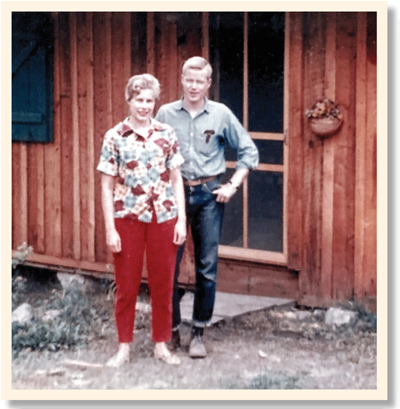 The couple at their “home away from home,” a cabin they built together in Marble, Colorado.
The couple at their “home away from home,” a cabin they built together in Marble, Colorado.There were many aspects of Grinnell College that were important to my father: learning from and later working with the professors, running track and cross country, being a trustee, succeeding as an administrator, and, of course, the years he spent as a professor. Yet the most important part of Grinnell to him by far was meeting my mom, Sue Ratcliff Drake ’58. They did not date as students. Mom always said he was “too smarty” for her, and she shied away because so many people were in awe of him. As fate would have it, he hitched a ride with her back to Chicago after a homecoming weekend. She recalls that he spent the majority of the ride hanging over the seat, “talking my ear off!” Soon after, he asked her out. Several months later, they were married — a partnership that lasted more than 62 years.
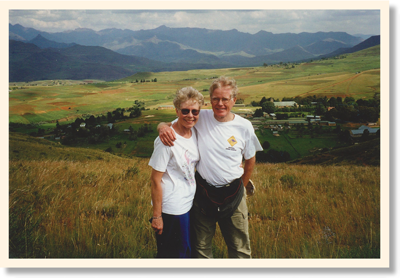 George and Sue, who taught in Lesotho during their Peace Corps service, pictured in southern Africa.
George and Sue, who taught in Lesotho during their Peace Corps service, pictured in southern Africa.Even though Dad started his teaching journey at Colorado College, he remained close to Grinnell in spirit. While in Colorado, he joined Grinnell’s Board of Trustees; and, in 1979, when a trustee encouraged him to consider the presidency, he was honored but wary because of his own father’s experience. My grandfather had been president of Doane College in Crete, Nebraska, during the World War II era, and he struggled in that role, in part because he supported the notable Japanese population on campus when many others did not. My father sensed that his situation would be different. Having been a trustee meant he already had his finger on the pulse of the College and was aware of challenges he might face. So, this time, my dad didn’t heed his father’s warning but instead opted to take on the role.
Dad’s humility served him well as president, as did his way of connecting with others. He often described himself as a “pushover,” feeling he could be swayed easily to another opinion. But I’ve come to learn that this was not an apt description of his leadership style. He was an active listener who considered all sides when making decisions. He kept open office hours, meeting with students, faculty, alumni, and staff who requested his time. This sometimes meant he was delayed in coming home or getting to another meeting, but he remained fully present and rarely let on that he had other commitments.
Interactions with my father were not limited to his office walls. He was regularly spotted around campus. At the dining hall, he frequently joined students to chat with them while eating at their table. He attended various campus events, and his love of sports put him in the stands or on the sidelines at many games and meets. There is a rare student who doesn’t recall seeing Dad running or him greeting them while bicycling past.

Grinnell Presidency
•
1979
Selected to serve as Grinnell’s 10th president and first alumnus president
•
1979–1991
During his tenure, Grinnell’s reputation as a liberal arts institution grows stronger; College is consistently rated a top national liberal arts college; endowment grows from $45 million to $300 million; diversity initiatives grow enrollment of Black students and Iowa students; Grinnell-Nanjing Exchange launches
•
May 4, 1980
Inaugural address; speaks of a vision of the “future in the past” and the College’s progressive ideals of service, its traditions of scholarship, academic freedom, and liberal dissent, and a purposeful future for Grinnell
•
1980s
Receives four honorary degrees — Colorado College, LLD,1980; Ripon College, LLD, 1982; Illinois College, LHD, 1985; and Ursinus College, LHD, 1988
•
1991
Board of Trustees honors presidential service, creates the George Drake Professor of Religious Studies
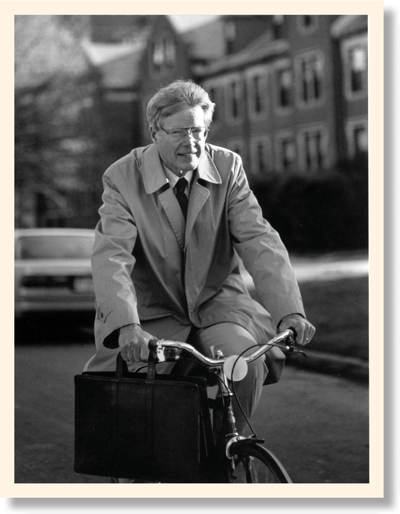 A familiar sight on campus; George biking past the North campus residence halls, circa 1980s.
A familiar sight on campus; George biking past the North campus residence halls, circa 1980s.Dad mostly went with the flow, even when, in typical Grinnell fashion, students would stage a protest or pull a lighthearted prank on him. Early in his presidency, a fake mailing went out to all first-year students inviting them to our house for an ice cream social. My sister and I, the ones home at the time, spent the better part of an hour politely turning away dozens of confused students. Our father was amused by this practical joke while simultaneously applauding the idea. The next year, he and my mom hosted a real ice cream social, which became an annual tradition.
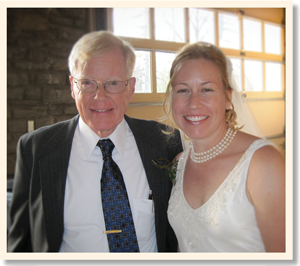 The author and her dad on the day she married Tom Wickersham ’90.
The author and her dad on the day she married Tom Wickersham ’90.When I decided to attend Grinnell, my dad was both overjoyed and wary. Still the College’s president, he worried he’d end up mired in some hot-topic issue that would suck me in as well. I, too, experienced both emotions. I knew enough students already to sense that they could separate me from who my dad was, but I also wanted to be distanced from the Drake name. Yet I kept coming back to Grinnell as my top choice. My parents had always told me to trust my gut, which I did. Four years later, I walked across the Commencement stage, proudly joining my parents as an alum. The Grinnell bond we share has been incredibly meaningful, and we’ve delighted at the fact that Mom and I both took classes from art professor Richard Cervene and Dad and I both lived on Younker’s third floor — my room was across the hall from where his was.

Service, Teaching, and Writing
•
1991–93
George and Sue join the Peace Corps and serve in Lesotho in southern Africa; George teaches at a high school and Sue travels to regional schools training teachers.
•
1993–2022
George and Sue give their time and talents widely to the community through the library, United Church of Christ, the hospital, and Mayflower Community; George parlays lifelong love of singing into performing and fundraising with Shults & Co.
•
1994–2004
Resumes teaching history at the College on a full-time basis
•
2002
Grinnell College Athletic Hall of Fame induction for Men's Track and Field, Men's Cross Country
•
2004
Assumes Professor Emeritus status but continues his love of teaching on a parttime basis mainly through tutorial on campus and in Grinnell’s Liberal Arts in Prison Program at Newton Correctional Facility
•
2006
Receives Grinnell College Distinguished Alumni Award; Sue is honored in 2008
•
2008
Drake Community Library named in honor of the couple’s longtime dedication to the town's public library
•
2019
Publishes Mentor: Life and Legacy of Joe Rosenfield
•
2020
In the face the global COVID-19 pandemic, George reluctantly elects to stop teaching
•
Fall 2021
Publishes his final book Seventy Years in Academe: A Memoir
•
2021–22
Despite pancreatic cancer diagnosis, George remains deeply involved and connected to the College
•
Oct. 15, 2022
George Albert Drake, a good man who lived richly and well, dies at the age of 88, in his Grinnell home surrounded by his loving family
While he was a successful president, Dad’s true career love was teaching. He was fully in his element when engaging with students. He continued teaching well into his emeritus status, each year asking students and colleagues alike to let him know if it was time for him to step back. In the latter years, as Grinnell continued to request his presence as an adviser and tutorial teacher, Dad’s only complaint was about technology, which outpaced his knowledge.
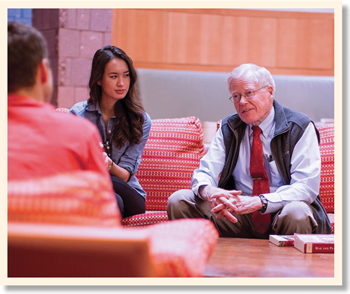 A quintessential image of George, professor and mentor, talking with students.
A quintessential image of George, professor and mentor, talking with students.When a global pandemic forced his hand, Dad stopped formally teaching, recognizing his limits with online instruction. Yet he never truly hung up his professor’s hat, remaining connected with students who often came by the house to visit. There are still students on campus today who have benefited from his tutelage. One even asked him for a recommendation letter this past fall.
Dad often said it was an honor to teach students, and this was most pronounced when he spoke of teaching in the Grinnell Liberal Arts in Prison Program. He loved these students deeply, celebrating their humanity, curiosity, and intellect. He kept up with alumni from these classes, even traveling with several of them to showcase the program at regional alumni events. One of the most meaningful conversations Dad had in his last days was with a student from this program who called to explain the incredible impact George Drake had on him. Dad was having difficulty speaking, but, at the end of that call, he told his student, “I’m listening.”
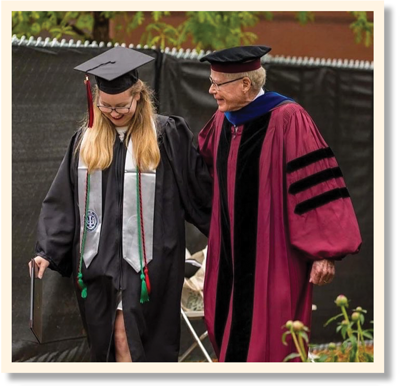
George delighted granddaughter Hannah when he made a surprise appearance to present her diploma at the 2018 Commencement ceremony.
In 2019, at age 84, my father authored a biography aptly titled Mentor about the legacy of Joe Rosenfield 1925, who committed much of his life to the college he loved so well. I had the unique privilege of observing Dad’s research and writing process. It energized him to delve into the story of this beloved man he had known and respected. I loved reading his early manuscripts and hearing the stories that didn’t make it into the book. A historian at heart with a great passion for Grinnell College, Dad was overjoyed to explore both interests in a book that also gave tribute to someone he admired.
Recently, my family rediscovered a recording of Dad teaching a Mayflower Community “bucket course” about Joe at the town’s Drake Community Library. I relished watching his lively storytelling of Joe’s deep and rich contributions to Grinnell. Anyone who had the pleasure of being taught by my father knows that he did not simply lecture. He engaged students, often knowing enough about them that he made personal connections to the subject at hand. By linking history to the present day, he brought relevancy to the topic while peppering it all with a healthy dose of humor.
Dad started the bucket course by reading the foreword, penned by Joe’s lifelong friend, Warren Buffett, who served on the College’s Board of Trustees with Joe. Listening to Dad read Buffett’s words describing Joe as “wise, humorous, generous, friendly, public-spirited” struck a chord. These are words often associated with my dad. Later, in the foreword, Buffett states, “Joe loved the Grinnell students as he loved the members of his own family.” This, too, parallels how my father connected with students. Growing up, we often had students at our dinner table, and some even stayed with us during College breaks, quickly becoming an extension of our family. Buffett ends by describing Mentor as “a story that could not have been written without a lifetime love affair between Joe Rosenfield and Grinnell College.” Similarly, this deep love of the College is embodied in the life of George Drake. As Dad states in his own memoir, Seventy Years in Academe, “I was very lucky in my choice of Grinnell and in Grinnell’s choice of me … I am a Grinnell College junkie.”
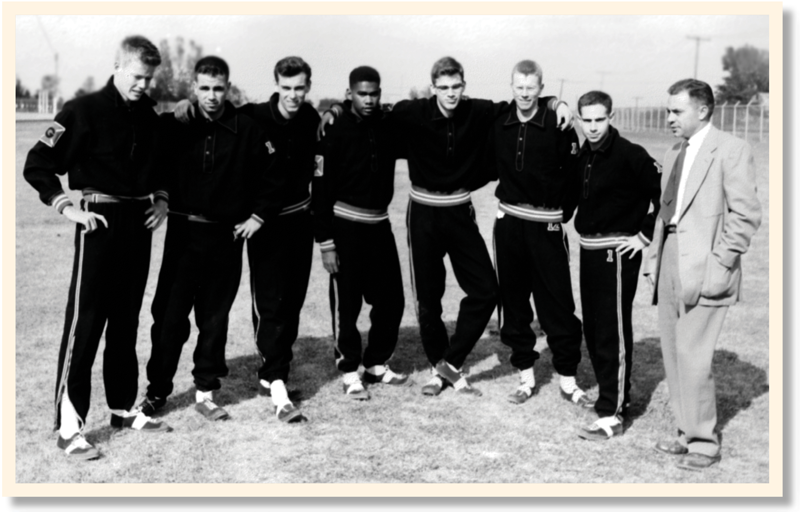 Cross country team photo taken just before George broke a course record in 1953 (George, far left).
Cross country team photo taken just before George broke a course record in 1953 (George, far left).